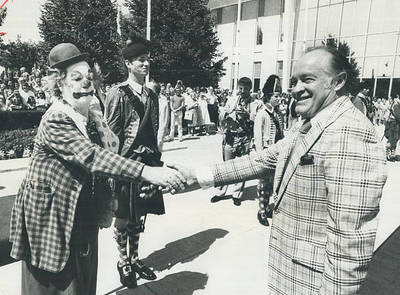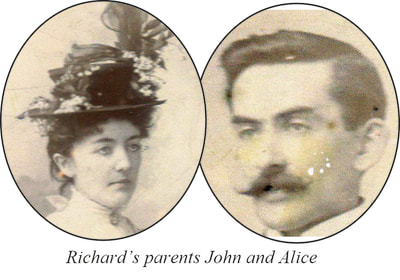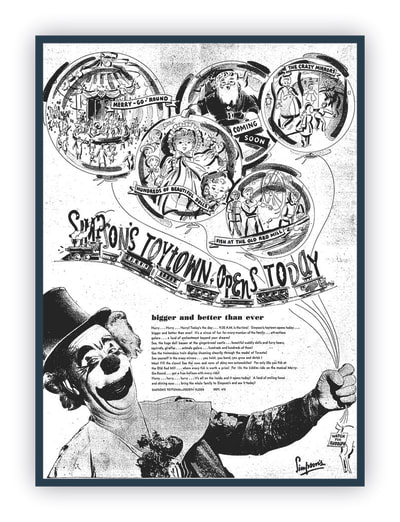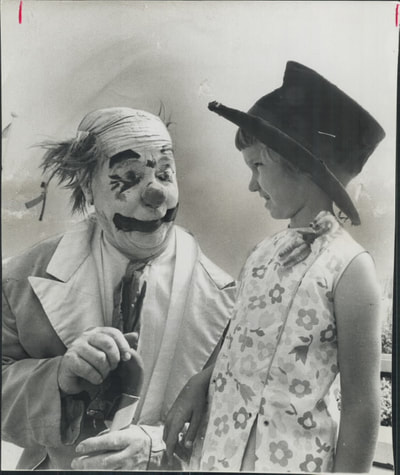The Tears of a Clown
Richard M O’Mahony
The Life of Richard Mandeville O’Mahony
Canada’s Famous Clown Fifiby Gwynneth Bennet (nee O'Mahony)
Article especially written for the BHCARA's Canada 150 Magazine - 2017
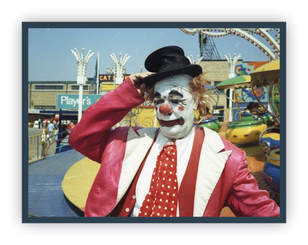
Family traditions told of a great uncle who had disappeared in Canada. In 2007 having visited uncles and aunts the only information available was that he had gone to Canada and had become a clown called Fifi. Intensive research over several years revealed, in bite-size pieces, not only a history of Richard but also a previously unknown family in Canada who were unaware of their origins.
The first breakthrough in information came from the online archives of the "Toronto Star" . A subscription allowed access to what can only be described as a wealth of information which included advertisements for Fifi's appearances at show and fairs in the area and, in shops at Christmas, and articles that told of his personal life. It became quite clear that Richard was publicly well known. It appeared he had married and had four children. So the immediate research then turned to trying to locate our 'Canadian Family.'
The computer age is wonderful for family research and within the last 8 years the amount of information online has expanded at a tremendous rate. Even back in 2008 there were sufficient resources to access for international information and after a couple of false leads we were able to make contact with the family through lateral thinking and the discovery of a family aunt on Richard's wife's side of the family who luckily had the same initials as his wife. Our approach to the family was welcomed and is wonderful to record that we have a growing and thriving branch of the family in Canada.
The "Toronto Star" confirmed that Richard had started life in Dover, Kent, England. In the early 1900s Dover was very much a garrison town. John Evelyn O'Mahony, Richard's father, had left Ireland in 1886 when he joined the 21st Hussars . His father Thomas O'Mahony of the Old Square Mitchelstown had been a respected Land Agent who worked for the Kingston Estate. Life for this family erupted due to the political and social conditions in Ireland prior to 1881, culminating in riots and boycotting against the family. They caused the family to leave hearth and home with Thomas and the youngest children going to Liverpool as a family unit. But for the older children it meant dispersal.
John Evelyn was the third son of Thomas to enter the army as his two older brothers had joined the Royal Irish Regiment in Cahir in 1883. John ended his six years' service, which had included action in India, in Canterbury in 1891 and was then on the reserves. Here he met Alice Sinclair, daughter of Richard Sinclair the military artist and photographer. Married in 1891 John Evelyn and Alice spent the early years of their married life in Manchester where their first son and then daughter were born. They appear to have been happy from the tone of letters to and from each other.
This was a time of great poverty in Manchester and they lived in housing designed for the workers in the cotton mills. Overcrowding was rife and often several large families shared a room. Engels, writing at the time, described vividly the shocking conditions of the working classes in Industrial Manchester.
By 1896 when their third child was born they had moved to Dover and were living in a little terraced house in Wyndham Road. John was working for the Hart & Company Furniture Firm. Richard Mandeville was born on the 2nd January 1905 at the house in Wyndham Road, in the Catholic Parish of St Peter. He was the third son and fifth child of John and Alice, but was not baptized until the 30th July 1905.
The Catholic register records his name as Joseph Mandeville which was obviously an error as he was always known and documented as Richard Mandeville. By July, within months of his birth, the family had moved to another terraced house in Heathfield Ave in the shadows of Dover Castle which dominated the area. This was the first indication of trouble.
Quite what happened in the family to cause the disastrous breakup is not known. With much patient research and in correspondence with the Catholic Children's Society we eventually pieced together some facts.
In October 1905 Richard and his eldest sister Dorothy were placed in the Catholic Children's home for boys which had recently been opened by the nuns in Eastbrook Place, Maison Dieu Rd. We assume Dorothy was placed there (she was the only girl) to care for Richard as he was such a young baby. The other children were also abandoned and were scattered. How long Dorothy was able to stay there is unknown. Richard appears to have been there until 1910 when just months after his 5th birthday he alone, on Thursday 25th August, was at 12:10 pm admitted to the Buckland Dover Union workhouse.
A letter was written by the Guardians on the day of his entry requesting his mother to collect him and the address given for her was 'Poste Restante, Paris'. It also recorded the whereabouts of John Evelyn as unknown. Dorothy is recorded as living in St Mildred's Convent, Minster which was one of the Magdalen Laundries. Richard, alone and unloved, was to remain in the workhouse for six more years. Letters at the time in the workhouse records show the spartan lifestyle and although the children went to the local school they were humiliated by being dressed in striped material and by having shorn hair. But even this must have formed a welcome break from the monotony of picking oakum (the removal of tar from used rope which damaged the fingers).
England had a major problem at this time with so many abandoned and homeless children. Changing thoughts and ideas led to philanthropic attempts to improve the situation by individuals and agencies such, as the Church. A new school in Orpington, St Joseph's Orphanage, was opened by the Catholic Brothers. Richard was selected to go and was discharged from the workhouse on the 14th July 1916 with the aim of being trained as a farm labourer and ready for a life in one of the former colonial countries. Richard was educated here and we find he learnt to play the piano as well as practical farming skills. He thus spent the years of the First World War in Orpington. After a hiatus in the transport of children abroad during the War, by 1920 the ships that had been taking soldiers from the USA and Canada home were being released for civilian work and so the transportation of thousands of children started again.
Amongst a few boxes of records recently discovered in the attic of Father Hudson's Society in Coleshill, Birmingham, were Richard's records and thus we have a very clear knowledge of his struggle with life from 1920 to 1926. He was given a choice of destination for emigration and evidently chose to go to Canada. He travelled north to join a group of boys from Father Hudson's. When the boys set off to Liverpool this must have been like a big adventure under the leadership of the Rev Patrick Joseph Healy. On the 27th August 1920 they departed on the RMS Minnedosa This passenger cargo vessel had been built on the Clyde by Barclay Curle & Co, Glasgow and was launched in Oct 1917. It was scrapped in 1949. We can only imagine the fun and laughter these boys had on the journey heading for a new life. Listed as 'Waifs and Strays' on the ships manifest they were also classified as Catholic Migration Society. They arrived in Quebec on the 4th September 1920.
Richard spent the next few months in the St Georges Home Ottawa. This Catholic home placed the newly arrived children into homes and farms in the wider area under an 'indenture' scheme whereby they agreed to work for 5 years for a small amount of pay which was then saved for them and given to them on their release. Richard's first placement could not have been more unfortunate. Laprairie is situated on the south bank of the St Lawrence river overlooking Montreal. To the south of the town was the farm of Ovide Lamarche near the banks of the river, a lovely place in summer but the winters would have been bitterly cold. However the main problem was the fact that this family were French speakers. The experience of these 'Home' children varied enormously and some became members of the family. Others like Richard were used as cheap labourers. So for Richard his life was once again filled with hurt and rejection. After a few months the nuns realised he was in distress and quickly removed him from Laprairie. He then went to Miss Doyle at Billings Bridge, Russell Co, Thos Stinson at South Gloucester and finally to Miss McGrath at Manotick. He suffered neglect and hardship before completing his indenture in 1926.
Reports in the Toronto Star state that Richard ran away to become a clown in the circus, which fits as a romantic witness to the spirit of resilience that must have dwelt deep within the character of this young man. However he was at this stage actually free to make his own choices. We do not know how he came to join the circus but with Bernardi's Circus as a starting ground he developed his innate skill of making people laugh and became Fifi the clown. It was not long before he was being referred to as 'beloved Clown' and 'Canada's Famous Clown'. It is thought that he wished to return to the family and live in the UK but that rejection again haunted him and he returned to being a clown in the Toronto area.
Possibly this added sadness created a reckless state of mind for in 1934 his name hit the newspaper again this time for entering the USA without permission. It is reported that a circus that had fired their clown, Muggo, hired Richard, and had then travelled across the border to Buffalo, USA. There he was apprehended by the authorities.
Richard had to resort to writing to the nuns at the home in Ottawa. This was a beautiful handwritten letter to which the Mother Superior replied by sending a letter of verification to the authorities. He was then able to return home.
The Toronto Star recorded the main features of Richards's life for the next few years. As Fifi he performed in many local venues such as Sunnyside, Centre Island, Simpsons Department Store, Royal York Hotel and the Maple Leaf Gardens. One of his most important roles was at the annual agricultural show in Toronto, the Canadian National Exhibition. He also did annual benefit shows for the Orphans Home and the Hospital for Sick Children. This appears to have been a period of relative happiness and normality.
Some time prior to 1938 Richard met Voila McQuain, the daughter of Mr and Mrs Wesley McQuain of Huntsville. She was from one of the pioneering families of that area and had moved to Toronto in 1838. They planned to marry but true to the character of Richard he managed to make this into a drama. Quite what was the truth we will never know but he certainly created a story for the papers. They report that he mislaid the marriage licence and thus the wedding was delayed for six hours. Richard and Voila eventually went to the wedding reception so as not to let down the guests and there they were told that the important piece of paper had been picked up in the street. It was returned via the Rev Parks who was then at a very late hour able to take the ceremony. Despite the nomadic life-style that being a clown imposed on Richard, he and Voila had three daughters and then a son. Richard's roaming life and sporadic work pattern must have caused difficulties, both emotionally and financially, and for many years the children lived in Huntsville with their mum and grandparents. This hard working and selfless couple had wonderful values and they gave the children security and sustenance, but above all taught them by example and expression how to love and have relationships.
The most stable time for the family was during the Second World War when Richard joined the Canadian Royal Air force in 1940 and an income was regular. He naturally took on the role of entertaining the troops and worked inthis capacity until November 1943. Sadly, but understandably, Richard, who as a child and infant had never been shown love or been taught to love, was unable to sustain the marriage relationship and thus became yet another member of the extended family to sustain a marriage breakup. In her teens Barbara, Richard's eldest daughter, moved to and worked in Toronto. She read about her dad's life as a clown in the papers but occasionally saw him in the street. In 1947 a series of photos of 'Fifi' when he was part of the Garden Bros Circus were taken by Gilbert A Milne, a professional photographer.
In 1976 he was introduced to Bob Hope at the Canadian National Exhibition and was still working in 1984. A final newspaper article reports that he was living a lonely existence in Toronto in poverty. However when he was in hospital a few years later he gave Voila's name as next of kin and although estranged for many years she came to collect Richard and took him home to nurse him back to health. He thus was known latterly to his children prior to spending the last few years of his life in a nursing home in Toronto.
On Nov 11th 2002 Richard died aged 97 years. He is remembered by a plaque on the wall in St John's (Norway) Cemetery, Scarborough, Toronto. We found him just six years too late as we would dearly love to have told him about his English family. A photo taken of him at this stage of life bore a close resemblance to our dear uncle Pat.
The first breakthrough in information came from the online archives of the "Toronto Star" . A subscription allowed access to what can only be described as a wealth of information which included advertisements for Fifi's appearances at show and fairs in the area and, in shops at Christmas, and articles that told of his personal life. It became quite clear that Richard was publicly well known. It appeared he had married and had four children. So the immediate research then turned to trying to locate our 'Canadian Family.'
The computer age is wonderful for family research and within the last 8 years the amount of information online has expanded at a tremendous rate. Even back in 2008 there were sufficient resources to access for international information and after a couple of false leads we were able to make contact with the family through lateral thinking and the discovery of a family aunt on Richard's wife's side of the family who luckily had the same initials as his wife. Our approach to the family was welcomed and is wonderful to record that we have a growing and thriving branch of the family in Canada.
The "Toronto Star" confirmed that Richard had started life in Dover, Kent, England. In the early 1900s Dover was very much a garrison town. John Evelyn O'Mahony, Richard's father, had left Ireland in 1886 when he joined the 21st Hussars . His father Thomas O'Mahony of the Old Square Mitchelstown had been a respected Land Agent who worked for the Kingston Estate. Life for this family erupted due to the political and social conditions in Ireland prior to 1881, culminating in riots and boycotting against the family. They caused the family to leave hearth and home with Thomas and the youngest children going to Liverpool as a family unit. But for the older children it meant dispersal.
John Evelyn was the third son of Thomas to enter the army as his two older brothers had joined the Royal Irish Regiment in Cahir in 1883. John ended his six years' service, which had included action in India, in Canterbury in 1891 and was then on the reserves. Here he met Alice Sinclair, daughter of Richard Sinclair the military artist and photographer. Married in 1891 John Evelyn and Alice spent the early years of their married life in Manchester where their first son and then daughter were born. They appear to have been happy from the tone of letters to and from each other.
This was a time of great poverty in Manchester and they lived in housing designed for the workers in the cotton mills. Overcrowding was rife and often several large families shared a room. Engels, writing at the time, described vividly the shocking conditions of the working classes in Industrial Manchester.
By 1896 when their third child was born they had moved to Dover and were living in a little terraced house in Wyndham Road. John was working for the Hart & Company Furniture Firm. Richard Mandeville was born on the 2nd January 1905 at the house in Wyndham Road, in the Catholic Parish of St Peter. He was the third son and fifth child of John and Alice, but was not baptized until the 30th July 1905.
The Catholic register records his name as Joseph Mandeville which was obviously an error as he was always known and documented as Richard Mandeville. By July, within months of his birth, the family had moved to another terraced house in Heathfield Ave in the shadows of Dover Castle which dominated the area. This was the first indication of trouble.
Quite what happened in the family to cause the disastrous breakup is not known. With much patient research and in correspondence with the Catholic Children's Society we eventually pieced together some facts.
In October 1905 Richard and his eldest sister Dorothy were placed in the Catholic Children's home for boys which had recently been opened by the nuns in Eastbrook Place, Maison Dieu Rd. We assume Dorothy was placed there (she was the only girl) to care for Richard as he was such a young baby. The other children were also abandoned and were scattered. How long Dorothy was able to stay there is unknown. Richard appears to have been there until 1910 when just months after his 5th birthday he alone, on Thursday 25th August, was at 12:10 pm admitted to the Buckland Dover Union workhouse.
A letter was written by the Guardians on the day of his entry requesting his mother to collect him and the address given for her was 'Poste Restante, Paris'. It also recorded the whereabouts of John Evelyn as unknown. Dorothy is recorded as living in St Mildred's Convent, Minster which was one of the Magdalen Laundries. Richard, alone and unloved, was to remain in the workhouse for six more years. Letters at the time in the workhouse records show the spartan lifestyle and although the children went to the local school they were humiliated by being dressed in striped material and by having shorn hair. But even this must have formed a welcome break from the monotony of picking oakum (the removal of tar from used rope which damaged the fingers).
England had a major problem at this time with so many abandoned and homeless children. Changing thoughts and ideas led to philanthropic attempts to improve the situation by individuals and agencies such, as the Church. A new school in Orpington, St Joseph's Orphanage, was opened by the Catholic Brothers. Richard was selected to go and was discharged from the workhouse on the 14th July 1916 with the aim of being trained as a farm labourer and ready for a life in one of the former colonial countries. Richard was educated here and we find he learnt to play the piano as well as practical farming skills. He thus spent the years of the First World War in Orpington. After a hiatus in the transport of children abroad during the War, by 1920 the ships that had been taking soldiers from the USA and Canada home were being released for civilian work and so the transportation of thousands of children started again.
Amongst a few boxes of records recently discovered in the attic of Father Hudson's Society in Coleshill, Birmingham, were Richard's records and thus we have a very clear knowledge of his struggle with life from 1920 to 1926. He was given a choice of destination for emigration and evidently chose to go to Canada. He travelled north to join a group of boys from Father Hudson's. When the boys set off to Liverpool this must have been like a big adventure under the leadership of the Rev Patrick Joseph Healy. On the 27th August 1920 they departed on the RMS Minnedosa This passenger cargo vessel had been built on the Clyde by Barclay Curle & Co, Glasgow and was launched in Oct 1917. It was scrapped in 1949. We can only imagine the fun and laughter these boys had on the journey heading for a new life. Listed as 'Waifs and Strays' on the ships manifest they were also classified as Catholic Migration Society. They arrived in Quebec on the 4th September 1920.
Richard spent the next few months in the St Georges Home Ottawa. This Catholic home placed the newly arrived children into homes and farms in the wider area under an 'indenture' scheme whereby they agreed to work for 5 years for a small amount of pay which was then saved for them and given to them on their release. Richard's first placement could not have been more unfortunate. Laprairie is situated on the south bank of the St Lawrence river overlooking Montreal. To the south of the town was the farm of Ovide Lamarche near the banks of the river, a lovely place in summer but the winters would have been bitterly cold. However the main problem was the fact that this family were French speakers. The experience of these 'Home' children varied enormously and some became members of the family. Others like Richard were used as cheap labourers. So for Richard his life was once again filled with hurt and rejection. After a few months the nuns realised he was in distress and quickly removed him from Laprairie. He then went to Miss Doyle at Billings Bridge, Russell Co, Thos Stinson at South Gloucester and finally to Miss McGrath at Manotick. He suffered neglect and hardship before completing his indenture in 1926.
Reports in the Toronto Star state that Richard ran away to become a clown in the circus, which fits as a romantic witness to the spirit of resilience that must have dwelt deep within the character of this young man. However he was at this stage actually free to make his own choices. We do not know how he came to join the circus but with Bernardi's Circus as a starting ground he developed his innate skill of making people laugh and became Fifi the clown. It was not long before he was being referred to as 'beloved Clown' and 'Canada's Famous Clown'. It is thought that he wished to return to the family and live in the UK but that rejection again haunted him and he returned to being a clown in the Toronto area.
Possibly this added sadness created a reckless state of mind for in 1934 his name hit the newspaper again this time for entering the USA without permission. It is reported that a circus that had fired their clown, Muggo, hired Richard, and had then travelled across the border to Buffalo, USA. There he was apprehended by the authorities.
Richard had to resort to writing to the nuns at the home in Ottawa. This was a beautiful handwritten letter to which the Mother Superior replied by sending a letter of verification to the authorities. He was then able to return home.
The Toronto Star recorded the main features of Richards's life for the next few years. As Fifi he performed in many local venues such as Sunnyside, Centre Island, Simpsons Department Store, Royal York Hotel and the Maple Leaf Gardens. One of his most important roles was at the annual agricultural show in Toronto, the Canadian National Exhibition. He also did annual benefit shows for the Orphans Home and the Hospital for Sick Children. This appears to have been a period of relative happiness and normality.
Some time prior to 1938 Richard met Voila McQuain, the daughter of Mr and Mrs Wesley McQuain of Huntsville. She was from one of the pioneering families of that area and had moved to Toronto in 1838. They planned to marry but true to the character of Richard he managed to make this into a drama. Quite what was the truth we will never know but he certainly created a story for the papers. They report that he mislaid the marriage licence and thus the wedding was delayed for six hours. Richard and Voila eventually went to the wedding reception so as not to let down the guests and there they were told that the important piece of paper had been picked up in the street. It was returned via the Rev Parks who was then at a very late hour able to take the ceremony. Despite the nomadic life-style that being a clown imposed on Richard, he and Voila had three daughters and then a son. Richard's roaming life and sporadic work pattern must have caused difficulties, both emotionally and financially, and for many years the children lived in Huntsville with their mum and grandparents. This hard working and selfless couple had wonderful values and they gave the children security and sustenance, but above all taught them by example and expression how to love and have relationships.
The most stable time for the family was during the Second World War when Richard joined the Canadian Royal Air force in 1940 and an income was regular. He naturally took on the role of entertaining the troops and worked inthis capacity until November 1943. Sadly, but understandably, Richard, who as a child and infant had never been shown love or been taught to love, was unable to sustain the marriage relationship and thus became yet another member of the extended family to sustain a marriage breakup. In her teens Barbara, Richard's eldest daughter, moved to and worked in Toronto. She read about her dad's life as a clown in the papers but occasionally saw him in the street. In 1947 a series of photos of 'Fifi' when he was part of the Garden Bros Circus were taken by Gilbert A Milne, a professional photographer.
In 1976 he was introduced to Bob Hope at the Canadian National Exhibition and was still working in 1984. A final newspaper article reports that he was living a lonely existence in Toronto in poverty. However when he was in hospital a few years later he gave Voila's name as next of kin and although estranged for many years she came to collect Richard and took him home to nurse him back to health. He thus was known latterly to his children prior to spending the last few years of his life in a nursing home in Toronto.
On Nov 11th 2002 Richard died aged 97 years. He is remembered by a plaque on the wall in St John's (Norway) Cemetery, Scarborough, Toronto. We found him just six years too late as we would dearly love to have told him about his English family. A photo taken of him at this stage of life bore a close resemblance to our dear uncle Pat.
